

If the analog input comes into channel 2000 for instance, do this: You should also clamp your feedback just in case it dips below 0. 1500 would be used as the setpoint for the PIDAT instruction. Then use scaled_sp as the setpoint in your PIDAT instruction. quick transfer function automatically identifies the change. You would need to run your setpoint through this equation in ladder: Symbol tables used in the CX-Programmer can be.

You are using an signed integer on your HMI such that -2.5 on the screen = -25 in D500. For this reason, the second -B instruction will not be executed, and the operation result is 3,333 is handled as an absolute value without any further manipulation. You would scale your setpoint to work between 0 - 8000. The result of the first -B instruction is, 9,999 (D200) - 6,666 (D201) 3333 (D202) and the Carry Flag (CY) is turned OFF. Lets assume the analog input is -4 to 4 units and it ranges from 0-8000. I am not sure if this explanation is helping or not. You would need to scale your setpoint to 0-4095 to match your feedback. If 0-4095 means -3 to +3 (units, whatever your units are). Therefore your setpoint cannot be negative. So, if your input data bits are set to 12 for example, then your input range is from 0 to (2^12-1) or from 0 to 4095. Our complete portfolio of safety services, training and automation services will help you keep your people safe, protect your capital investments and increase your overall equipment effectiveness. The input range is set in number of input data bits. What I was referring to was the fact that if your analog input value coming in for the feedback dips below zero (when monitored as a signed integer), that would like a large number when monitored as an unsigned integer.


 0 kommentar(er)
0 kommentar(er)
